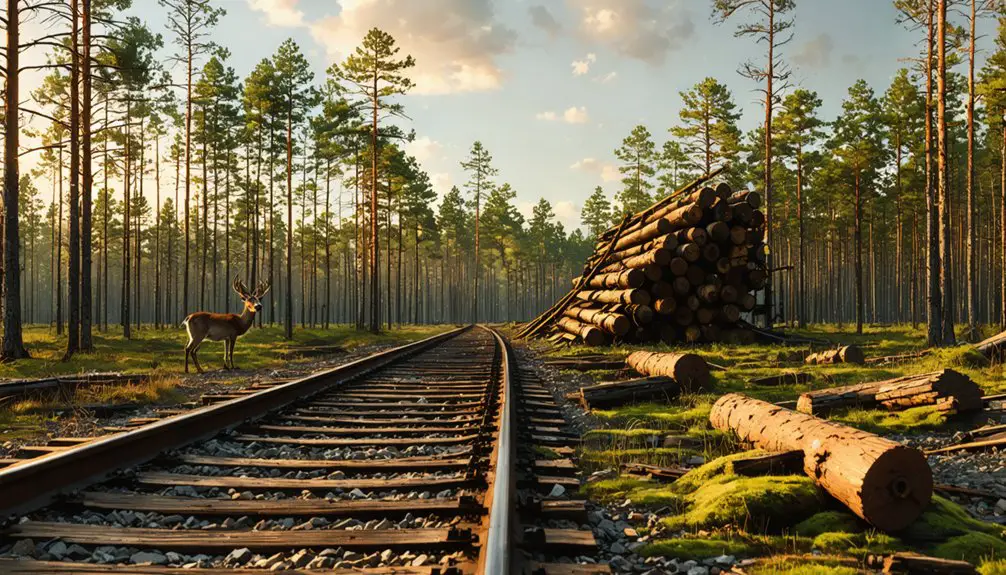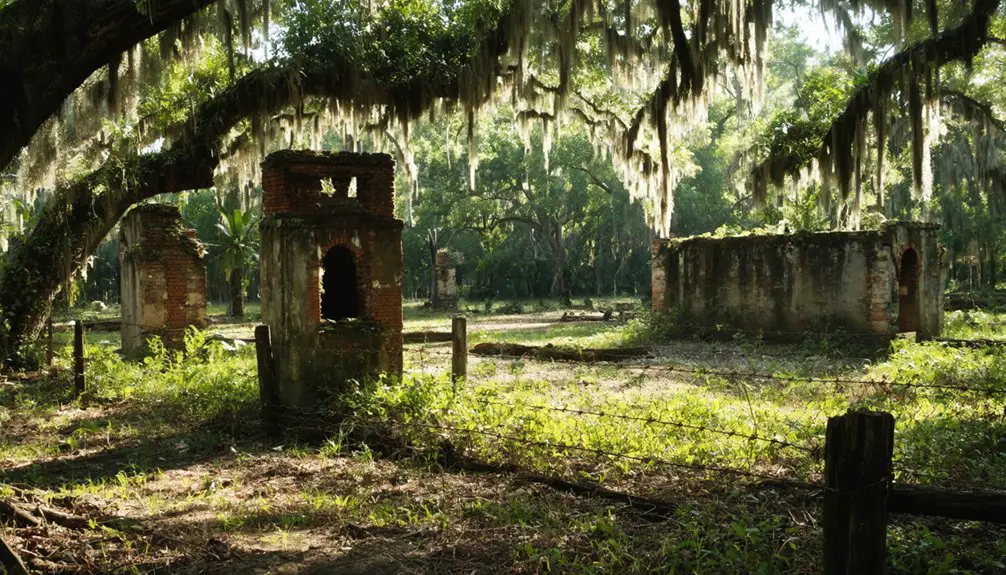You’ll find Deer Park’s ghost town legacy in central Florida, where George W. Hopkins built a booming logging community in the early 1900s. The town grew around the Union Cypress Company, with workers living in company housing and gathering at P.J. Kelly’s store. While timber operations have long ceased, you can still explore the historic site where Fort Taylor once stood and where traditional crafts like moss pillow making continue. The town’s untold stories await beneath towering pines and cypress stumps.
Key Takeaways
- Deer Park emerged as a thriving logging community in early 20th century Florida, centered around the Union Cypress Company operations.
- George W. Hopkins established the town’s foundation, providing worker housing and creating a close-knit industrial community.
- P.J. Kelly’s store and the Savage brothers’ trading post served as vital community hubs for residents until the town’s decline.
- The town transitioned from an active logging settlement to a ghost town as timber resources depleted and industry moved elsewhere.
- Today, the former town site is managed by Kempfer Ranch and Deseret Ranches, preserving its historical significance through oral histories.
The Rise of a Logging Empire

As Florida’s timber industry expanded in the early 20th century, Deer Park emerged as an essential logging hub through strategic land acquisitions and technological advances.
You’d find powerful landowners like Barron Collier securing vast timber rights, starting with Deep Lake and expanding throughout the region.
The transformation was driven by revolutionary logging technology – steam-powered sawmills replaced water-powered operations, while circular saws and power skidders accelerated production. New cross-cut saws and eight-wheeled logging wagons in 1900 helped drive peak production in southern forests.
Railroad networks, with spur lines placed every quarter mile, penetrated deep into previously inaccessible forests.
During the Great Depression, Edward Ball’s timber acquisition of over 1 million acres, backed by du Pont money, further intensified the industry.
The Depression era saw Edward Ball amass a timber empire exceeding 1 million acres through strategic du Pont financing.
The Lee Tidewater Cypress Company established a significant presence by the 1940s, complete with company houses and extensive sawmill operations.
Life in Early Deer Park
When George W. Hopkins founded Deer Park in the early 1900s, you’d find a bustling industrial town centered around his Union Cypress Company. Life revolved around the sawmill and planing mill operations, where workers and their families built strong community cohesion through shared experiences. The abundance of wild deer grazing along nearby waterways reminded settlers of the early days of Deerfield.
P. J. Kelly’s store became a central gathering place for residents after its opening in 1902.
- Workers lived in company-provided housing, creating tight-knit neighborhoods where families supported each other.
- Social activities typically centered around church gatherings and family events, reflecting the values of early 20th-century rural Florida.
- The post-military trading post, run by R.B. and J.N. Savage, served as a hub for commerce and social interaction.
- Daily routines were shaped by the rhythms of mill work and railroad schedules until the 1930s, when the town’s liveliness began to fade.
Later, the Kempfer ranch operations became the community’s backbone as timber industry declined.
Military Heritage and Fort Taylor

During the Second Seminole Wars of 1835-1842, Fort Taylor emerged as an essential military outpost along the St. Johns River.
You’ll find its military significance reflected in its strategic position, which helped control waterways and support U.S. Army operations throughout central Florida.
The fort’s architecture was typical of frontier outposts, featuring basic defensive structures suited for rapid deployment.
Unlike its namesake Fort Zachary Taylor in Key West, this installation didn’t boast massive granite walls or heavy artillery emplacements.
Construction began in 1845 to enhance coastal defenses, though this inland fort predated its more famous counterpart.
Instead, it served as a functional base during the brief but intense conflict with Seminole tribes.
After the military abandoned the fort in 1838, R.B. and J.N. Savage transformed it into a trading post, marking a shift from military operations to civilian commerce in Deer Park’s development.
Similar to the Old Deer Park in Richmond, London, the area around Fort Taylor featured expansive natural landscapes and local wildlife.
Natural Surroundings and Geography
The natural landscape of Deer Park reflects Florida’s diverse inland ecosystems, stretching across Osceola County south of U.S. Route 192. Similar to nearby Runnymede, the terrain spans gently rolling hills and wetlands.
Deer Park showcases Florida’s inland diversity, with its natural landscapes extending through Osceola County’s southern reaches beyond Route 192.
You’ll find a rich blend of pine flatwoods where sunlight filters through needle canopies, alongside hammock forests and high bluffs overlooking the St. Johns River system. The region’s wetland ecosystems feature tea-colored waters and spring-fed streams that weave through swampy lowlands. The area transitions distinctly from hammock to flatwoods, creating varied habitats for local wildlife.
- Towering bald cypress trees once dominated the swamps before extensive logging changed the landscape.
- Mixed hardwood and coniferous forests thrive in the humid subtropical climate.
- Creeks and natural springs sustain diverse wildlife populations.
- Seasonal rainfall patterns influence water levels in local wetlands, affecting land use patterns.
This natural setting has shaped the area’s development from early settlement through its evolution to ranching and forestry operations.
Ghost Town Legacy Today
Modern visitors to Deer Park’s ghost town legacy will find a complex blend of preserved history and natural reclamation.
You’ll discover that while physical remnants are scarce, cultural preservation continues through oral histories collected by local historians like Bill Dreggors and the stories passed down by descendants of original settlers.
Today, you can explore land that’s actively managed by both the Kempfer Ranch and Deseret Ranches, connecting the area’s past to its present agricultural use. The rich farming heritage mirrors communities like Bean City farmers, who once cultivated the land until natural disasters changed the landscape. Local residents maintain strong ties to traditional crafts, with many still practicing moss pillow making techniques passed down through generations.
While finding the old cemetery and fort ruins requires precise directions through overgrown terrain, ghost town enthusiasts and history buffs continue to seek out these hidden treasures.
The site draws niche tourism interest, especially from those documenting Florida’s vanished communities through social media and documentaries.
Frequently Asked Questions
Are There Any Reported Paranormal Activities or Ghost Sightings in Deer Park?
You won’t find documented ghostly encounters or spectral phenomena in Deer Park. While locals share vague feelings of unease, there’s no verified evidence of paranormal activity in this former mill town.
What Happened to the Original Residents When the Town Began Declining?
As jobs vanished and railroads closed, you’d find original residents moving to nearby towns, settling in Orlando-Kissimmee areas, or maintaining ranches in the region while seeking better economic opportunities elsewhere.
Can Visitors Legally Explore the Abandoned Structures in Deer Park Today?
You can’t legally explore abandoned structures without property owners’ permission. Due to exploration regulations and visitor safety concerns, you’ll need explicit authorization to avoid trespassing violations and potential hazards.
Which Original Buildings From Deer Park’s Heyday Still Remain Standing?
You’ll find six historic architecture survivors: the Baldwin House, Jimmy Ellenburg House, Bay Chateau, Hicks House, A-Frame House, and Powerboat Club, all protected through preservation efforts despite environmental damage.
How Accessible Is the Old Cemetery to Modern-Day Visitors?
Like a whispered secret in the woods, you’ll find cemetery access requires traversing unpaved roads and natural terrain. Follow visitor guidelines: visit during daylight, park roadside, and walk carefully through.
References
- https://floridanature.wordpress.com/2008/10/19/hunting-for-a-ghost-town-in-the-forest/
- https://www.hmdb.org/m.asp?m=221629
- https://en.wikipedia.org/wiki/Deer_Park
- https://www.youtube.com/watch?v=kXGAKmjGMXg
- https://www.youtube.com/watch?v=CBFrK-n4HmA
- https://npshistory.com/publications/bicy/sawmills.pdf
- https://www.srs.fs.usda.gov/pubs/ja/1979/ja_1979_crocker_001.pdf
- https://www.fnai.org/arrow-site/history/history-forestry
- https://stars.library.ucf.edu/cgi/viewcontent.cgi?article=4132&context=fhq
- https://foresthistory.org/wp-content/uploads/2017/01/Florida-National-Forests.pdf



